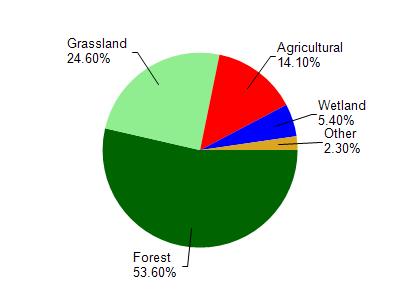Iowa
No
No
No
Fish and Aquatic Life
Overview
Dickinson Creek is a spring fed tirbutary to Otter Creek with some pools and riffles. It is a Class II trout stream and supports some natural reproduction of brook trout. Dickinson Creek has experienced problems with nonpoint source pollution from bank erosion.
From: Ripp, Coreen, Koperski, Cindy and Folstad, Jason. 2002. The State of the Lower Wisconsin River Basin. PUBL WT-559-2002. Wisconsin Department of Natural Resources, Madison, WI.
Date 2002
Author Cynthia Koperski
Historical Description
Dickinson Creek - Mouth Location T7N R2E Section 21 -16, Surface area = 1.9 acres, Length = 2.0 miles, Gradient = 10.0 feet per mile, Total alkalinity = 230.0 mg/l, Volume of flow = 1.1 cfs.
Dickinson Creek is a short tributary of Otter Creek. Its waters are furnished by a number of springs which enter throughout its length. Although it has a very low gradient in comparison to other streams its size found in the county, heavy erosion of its banks is especially evident near its mouth. There is a farm pond located at its headwaters and three more on a hollow further downstream, all of which contain warmwater fisheries. These ponds may warm up cold spring waters and thus affect trout, but the spring flow lost at the headwaters may have been compensated for by more groundwater recharging, less siltation and reduced flooding below. Although over 70 percent of its watershed is farmed; flooding, which was a very serious problem, has now definitely been reduced. From an electrofishing survey made in 1963, it appears that the trout fishery is still quite good although the exact status of natural reproduction is not known. The trout species
common to the fishery include brown and rainbow trout and brook trout have been found near its mouth. Forage fishes include bluntnose minnows, common and bigmouth shiners, redbelly and longnose dace, creek chubs, johnny darters, and white suckers.
From: Piening, Ronald and Threinen, C.W., 1968. Lake and Stream Classification Project. Surface Water Resources of Iowa County, Wisconsin Department of Natural Resources, Madison, WI.
Date 1968
Author Surface Water Inventory Of Wisconsin
General Condition
Dickinson Creek (WBIC 1238200) from Unnamed stream (WBIC 5035791) to headwaters was assessed during the 2018 listing cycle; new temperature sample data were clearly below the 2018 WisCALM listing thresholds for the Fish and Aquatic Life use. This water was meeting this designated use and was not considered impaired.
Date 2017
Author Ashley Beranek
General Condition
Dickinson Creek (miles 0-4.5) was assessed during the 2018 listing cycle; new biological (fish Index of Biotic Integrity (IBI) scores) sample data were clearly below the 2018 WisCALM listing thresholds for the Fish and Aquatic Life use. This water was meeting this designated use and was not considered impaired.
Date 2017
Author Ashley Beranek
Condition
Wisconsin has over 84,000 miles of streams, 15,000 lakes and milllions of acres of wetlands. Assessing the condition of this vast amount of water is challenging. The state's water monitoring program uses a media-based, cross-program approach to analyze water condition. An updated monitoring strategy (2015-2020) is now available. Compliance with Clean Water Act fishable, swimmable standards are located in the Executive Summary of Water Condition in 2018. See also the 'monitoring and projects' tab.
Reports
Management Goals
Wisconsin's Water Quality Standards provide qualitative and quantitative goals for waters that are protective of Fishable, Swimmable conditions [Learn more]. Waters that do not meet water quality standards are considered impaired and restoration actions are planned and carried out until the water is once again fishable and swimmable
Management goals can include creation or implementation of a Total Maximum Daily Load analysis, a Nine Key Element Plan, or other restoration work, education and outreach and more. If specific recommendations exist for this water, they will be displayed below online.
Monitoring
Monitoring the condition of a river, stream, or lake includes gathering physical, chemical, biological, and habitat data. Comprehensive studies often gather all these parameters in great detail, while lighter assessment events will involve sampling physical, chemical and biological data such as macroinvertebrates. Aquatic macroinvertebrates and fish communities integrate watershed or catchment condition, providing great insight into overall ecosystem health. Chemical and habitat parameters tell researchers more about human induced problems including contaminated runoff, point source dischargers, or habitat issues that foster or limit the potential of aquatic communities to thrive in a given area. Wisconsin's Water Monitoring Strategy was recenty updated.
Grants and Management Projects
Monitoring Projects
| WBIC | Official Waterbody Name | Station ID | Station Name | Earliest Fieldwork Date | Latest Fieldwork Date | View Station | View Data |
|---|
| 1238200 | Dickinson Creek | 10033663 | NCregcomp1-0121 Dickinson Cr. | 6/1/2011 | 1/1/2015 | Map | Data |
|

Watershed Characteristics
Dickinson Creek is located in the Otter and Morrey Creeks watershed which is 198.69 mi². Land use in the watershed is primarily forest (53.60%), grassland (24.60%) and a mix of agricultural (14.10%) and other uses (7.70%). This watershed has 437.57 stream miles, 351.55 lake acres and 5,785.74 wetland acres.
Nonpoint Source Characteristics
This watershed is ranked Not Ranked for runoff impacts on streams, Low for runoff impacts on lakes and High for runoff impacts on groundwater and therefore has an overall rank of High. This value can be used in ranking the watershed or individual waterbodies for grant funding under state and county programs.However, all waters are affected by diffuse pollutant sources regardless of initial water quality. Applications for specific runoff projects under state or county grant programs may be pursued. For more information, go to surface water program grants.